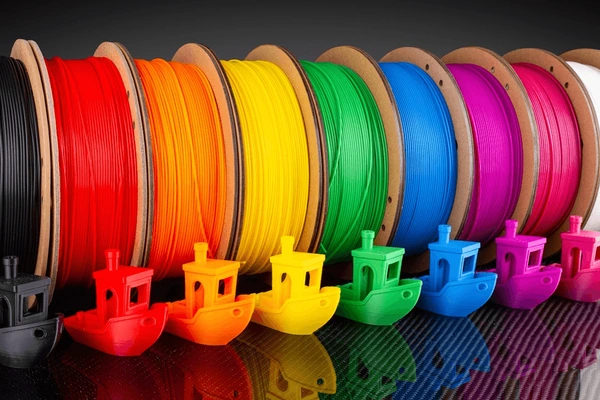
Introduction: PETG vs PLA
When it comes to 3D printing, PETG vs PLA is a common comparison for filament choice. PETG (Polyethylene Terephthalate Glycol-Modified) offers strength and durability, making it ideal for functional parts, while PLA (Polylactic Acid) is eco-friendly and easy to use, perfect for beginners. Understanding the differences between these materials helps you choose the right filament for your 3D printing projects.

What Is PETG?
PETG is a copolymer derived from polyethylene terephthalate (PET) and cyclohexanedimethanol (CHDM). It is an amorphous thermoplastic polyester with excellent impact resistance, transparency, and chemical resistance. The key characteristics of PETG are:
- Composition and Structure
- PETG is composed of terephthalic acid, ethylene glycol, and CHDM 235. The CHDM content typically ranges from 10-35 mol%.
- The chemical structure includes aromatic rings from terephthalic acid and aliphatic segments from CHDM, resulting in an amorphous polymer.
- Properties
- High impact strength and ductility due to the amorphous nature.
- Good transparency and clarity.
- Excellent chemical resistance, especially to acids and bases.
- Lower glass transition temperature (Tg) than PET, typically around 80-85°C.
- Good processability and ease of printing in additive manufacturing.
- Applications
- Widely used in 3D printing and additive manufacturing for its excellent printability.
- Food packaging and containers due to its clarity and chemical resistance.
- Medical devices and labware due to its biocompatibility and sterilizability.
- Electrical and electronic components for its insulating properties.

What Is PLA?
PLA is a biodegradable and bioactive thermoplastic polyester derived from renewable resources like corn starch or sugarcane. Its key features include:
- Composition and Structure
- PLA is a linear aliphatic polyester made from lactic acid monomers.
- It can be produced by ring-opening polymerization of lactide or direct polycondensation of lactic acid .
- Properties
- Biodegradable and compostable under suitable conditions.
- Good mechanical strength and stiffness, but relatively brittle.
- Low thermal resistance with a glass transition temperature around 60-65°C .
- Excellent printability and dimensional accuracy in 3D printing.
- Applications
- Widely used in 3D printing and additive manufacturing for prototyping and end-use parts.
- Packaging materials, disposable tableware, and agricultural films due to its biodegradability.
- Biomedical applications like implants and drug delivery systems due to its biocompatibility.
Key Differences Between PETG and PLA
Material Properties
- Composition: PETG (Polyethylene Terephthalate Glycol) is a copolyester derived from PET with added glycol, while PLA (Polylactic Acid) is a bioplastic made from renewable resources like corn starch or sugarcane.
- Mechanical Strength: PETG exhibits higher tensile strength, impact resistance, and ductility compared to PLA, making it more suitable for applications requiring durability and toughness.
- Temperature Resistance: PETG has a higher glass transition temperature and better heat resistance than PLA, allowing it to withstand higher temperatures without deformation.
Printing Characteristics
- Adhesion: PETG generally has better layer adhesion and less warping than PLA, resulting in better print quality and dimensional accuracy.
- Printing Temperature: PETG requires higher printing temperatures (around 230-260°C) compared to PLA (around 190-230°C), which can affect energy consumption and printer compatibility.
- Post-Processing: PETG is more resistant to chemicals and solvents, making it easier to post-process with techniques like sanding, painting, or vapor smoothing.
Environmental Impact
- Biodegradability: PLA is biodegradable and compostable, while PETG is not biodegradable but can be recycled.
- Renewable Resources: PLA is derived from renewable plant-based sources, making it a more environmentally friendly option compared to the petroleum-based PETG.
Applications
- PETG is widely used in food and beverage containers, cosmetic packaging, and medical applications due to its durability, chemical resistance, and FDA approval.
- PLA is commonly used in consumer goods, prototyping, and applications where biodegradability is desirable, such as disposable products or temporary structures.

When to Use PETG vs PLA
- Use PLA for simple, low-stress prints, prototyping, and when biodegradability is a priority.
- Choose PETG for functional parts, outdoor applications, or when higher impact resistance, temperature tolerance, and chemical resistance are required.
- Consider PETG for objects that may be exposed to moisture or need post-processing with solvents or vapor smoothing.
How to Print with PETG and PLA
Optimal printing parameters vary for PETG and PLA. PLA is typically printed at temperatures around 195-225°C, while PETG requires higher temperatures of around 240°C . Print speed, layer height, and cooling settings also impact print quality and mechanical properties. Dynamic flow calibration and adjusting parameters like infill density and wall thickness can optimize the printing process.
FAQs
- Which filament is better for beginners, PETG or PLA?
PLA is better for beginners due to its lower printing temperature, ease of use, and minimal warping. - Can PETG and PLA be used interchangeably?
Not always. PETG is better for functional, durable parts, while PLA is ideal for quick, decorative prints. - Which filament is more eco-friendly?
PLA is more eco-friendly as it’s biodegradable under industrial conditions, whereas PETG is recyclable but not biodegradable. - Is PETG harder to print than PLA?
Yes, PETG requires precise temperature control and may have issues like stringing and adhesion challenges compared to PLA. - How do I prevent warping when printing with PETG?
Use a heated bed, maintain proper bed adhesion, and ensure consistent ambient temperature to minimize warping.
To get detailed scientific explanations of PETG vs. PLA, try Patsnap Eureka.

